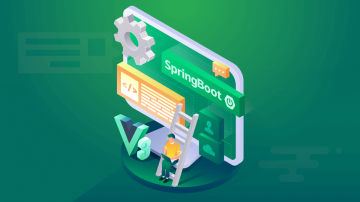本文将带你深入了解Spring Boot项目实战,从环境搭建到第一个Spring Boot应用的创建,再到配置和整合技术,帮助你快速掌握Spring Boot的开发流程和常用配置。
SpringBoot项目实战入门教程 SpringBoot简介SpringBoot是什么
Spring Boot 是一个用于简化新Spring应用程序初始搭建以及开发过程的框架。使用Spring Boot,你可以创建一个独立的基于Spring的应用程序。它允许你进行快速的脚手架开发,提供了默认配置以减少配置,同时允许你明确地配置你所需要的特性。
SpringBoot的优点
- 快速启动: Spring Boot 提供了许多自动配置,使得开发人员可以快速启动一个应用。例如,自动配置Tomcat服务器可以让你在几行代码内启动一个Web应用。
- 约定优于配置: Spring Boot 遵循约定优于配置的原则,这意味着它为许多常见的开发场景提供默认配置,从而减少了配置的工作量。
- 依赖管理: Spring Boot 管理了项目的依赖,包括Spring框架和其他库,通过Spring Boot Start,开发者可以方便地引入所需功能。
- 嵌入式Web服务器: Spring Boot 可以嵌入Tomcat、Jetty或Undertow作为HTTP服务器,无需单独安装和配置容器。
- 生产就绪特性: Spring Boot 提供了许多生产就绪特性,例如Actuator端点用于监控和管理应用运行状态。
SpringBoot的核心概念
- 自动配置: Spring Boot 试图自动配置应用程序中所需的bean,使其无需编写大量配置代码。例如,Spring Boot 会自动配置一个Tomcat服务器,使得开发人员无需手动配置。
- Starter依赖: Spring Boot 提供了一系列starter依赖,这些依赖库包含了开发所需的所有必需的依赖,如
spring-boot-starter-web、spring-boot-starter-data-jpa等。 - Actuator管理端点: Spring Boot Actuator 提供了多个端点,用于监控和管理应用的状态,包括健康状态、应用程序信息等。
- Spring Boot CLI: Spring Boot 还提供了一个命令行接口 (CLI) ,可以用来运行和测试你的应用程序,而不需要构建一个可执行的JAR文件。
- Spring Boot Devtools: 开发时提供一系列便捷工具,包括自动重启功能,这在开发过程中非常有用。
开发环境准备
在开始Spring Boot开发之前,你需要准备以下环境:
- Java 8+: Spring Boot 2.0及以上版本需要Java 8及以上版本。
- IDE: 推荐使用IntelliJ IDEA或Eclipse。
- Maven 或 Gradle: Spring Boot 使用Maven或Gradle进行构建和依赖管理。
Maven配置
使用Maven的pom.xml文件进行配置,如下所示:
<dependencies>
<dependency>
<groupId>org.springframework.boot</groupId>
<artifactId>spring-boot-starter-web</artifactId>
</dependency>
<!-- 其他依赖,如数据库连接 -->
</dependencies>
<properties>
<java.version>1.8</java.version>
</properties>
<build>
<plugins>
<plugin>
<groupId>org.springframework.boot</groupId>
<artifactId>spring-boot-maven-plugin</artifactId>
</plugin>
</plugins>
</build>Gradle配置
使用Gradle的build.gradle文件进行配置,如下所示:
dependencies {
implementation 'org.springframework.boot:spring-boot-starter-web'
// 其他依赖,如数据库连接
}创建SpringBoot项目
使用IDEA创建一个新的Spring Boot项目。在IntelliJ IDEA中,点击 File -> New -> Project,选择 Spring Initializr,输入项目的基本信息并选择所需的功能模块,例如Web、JPA等。IDEA会自动生成项目结构和基础代码。
配置项目环境
配置项目的pom.xml或build.gradle文件,确保包含Spring Boot的启动依赖。例如,使用Maven的pom.xml文件可以这样设置:
<dependencies>
<dependency>
<groupId>org.springframework.boot</groupId>
<artifactId>spring-boot-starter-web</artifactId>
</dependency>
<!-- 其他依赖,如数据库连接 -->
</dependencies>
<properties>
<java.version>1.8</java.version>
</properties>
<build>
<plugins>
<plugin>
<groupId>org.springframework.boot</groupId>
<artifactId>spring-boot-maven-plugin</artifactId>
</plugin>
</plugins>
</build>创建Hello World项目
创建一个简单的Spring Boot应用,该应用在访问/hello路径时返回一个简单的字符串。
- 在IDEA中创建一个新的Spring Boot项目。
- 在
src/main/java目录下创建一个包结构,例如com.example.demo。 - 在该包下创建一个主类
DemoApplication.java,代码如下:
package com.example.demo;
import org.springframework.boot.SpringApplication;
import org.springframework.boot.autoconfigure.SpringBootApplication;
import org.springframework.web.bind.annotation.GetMapping;
import org.springframework.web.bind.annotation.RestController;
@SpringBootApplication
public class DemoApplication {
public static void main(String[] args) {
SpringApplication.run(DemoApplication.class, args);
}
}
@RestController
class HelloWorldController {
@GetMapping("/hello")
public String hello() {
return "Hello World!";
}
}运行项目
- 使用IDEA的Run选项运行
DemoApplication类。 - 打开浏览器,访问
http://localhost:8080/hello,你会看到输出Hello World!。
项目目录结构解析
一个典型的Spring Boot项目的目录结构如下:
src
├── main
│ ├── java
│ │ └── com.example.demo
│ │ ├── DemoApplication.java
│ │ └── HelloWorldController.java
│ ├── resources
│ │ ├── application.properties
│ │ └── static
│ │ └── index.html
└── test
└── java
└── com.example.demo
└── DemoApplicationTests.java配置文件介绍
Spring Boot 通过配置文件application.properties或application.yml来进行配置。这些配置文件位于src/main/resources目录下。
例如,application.properties可以包含数据库连接配置:
spring.datasource.url=jdbc:mysql://localhost:3306/testdb
spring.datasource.username=root
spring.datasource.password=root
spring.datasource.driver-class-name=com.mysql.cj.jdbc.Driver常用配置项详解
- Spring Boot Actuator: 通过
spring-boot-starter-actuator依赖来启用。Actuator提供了一系列管理端点,用于监控和管理应用。
management.endpoints.web.exposure.include=*
management.endpoint.health.show-details=always- Spring Data JPA: 配置JPA以连接到数据库。
spring.jpa.hibernate.ddl-auto=update
spring.jpa.show-sql=true
spring.jpa.properties.hibernate.dialect=org.hibernate.dialect.MySQL5InnoDBDialect自定义配置
你可以创建自定义配置类来覆盖默认的配置。例如,创建一个CustomProperties类:
package com.example.demo.config;
import org.springframework.boot.context.properties.ConfigurationProperties;
import org.springframework.stereotype.Component;
@Component
@ConfigurationProperties(prefix = "custom")
public class CustomProperties {
private String property1;
private String property2;
// Getter and Setter
public String getProperty1() {
return property1;
}
public void setProperty1(String property1) {
this.property1 = property1;
}
public String getProperty2() {
return property2;
}
public void setProperty2(String property2) {
this.property2 = property2;
}
}在application.properties中配置属性:
custom.property1=value1
custom.property2=value2使用注入属性:
import com.example.demo.config.CustomProperties;
import org.springframework.beans.factory.annotation.Autowired;
import org.springframework.web.bind.annotation.GetMapping;
import org.springframework.web.bind.annotation.RestController;
@RestController
public class CustomPropertiesController {
@Autowired
private CustomProperties customProperties;
@GetMapping("/custom")
public String getCustomProperties() {
return "Property1: " + customProperties.getProperty1() + ", Property2: " + customProperties.getProperty2();
}
}SpringBoot与数据库的整合
使用Spring Boot整合数据库通常涉及JPA(Java Persistence API)或MyBatis等ORM工具。以下是一个使用Spring Data JPA的例子:
- 添加JPA依赖到
pom.xml:
<dependency>
<groupId>org.springframework.boot</groupId>
<artifactId>spring-boot-starter-data-jpa</artifactId>
</dependency>-
配置数据库连接信息到
application.properties。 - 创建一个实体类,例如
User.java:
package com.example.demo.entity;
import javax.persistence.Entity;
import javax.persistence.GeneratedValue;
import javax.persistence.GenerationType;
import javax.persistence.Id;
@Entity
public class User {
@Id
@GeneratedValue(strategy = GenerationType.IDENTITY)
private Long id;
private String username;
private String password;
// Getter and Setter
}- 创建一个数据访问层,例如
UserRepository.java:
package com.example.demo.repository;
import com.example.demo.entity.User;
import org.springframework.data.jpa.repository.JpaRepository;
public interface UserRepository extends JpaRepository<User, Long> {
}- 创建一个服务类,例如
UserService.java:
package com.example.demo.service;
import com.example.demo.entity.User;
import com.example.demo.repository.UserRepository;
import org.springframework.beans.factory.annotation.Autowired;
import org.springframework.stereotype.Service;
import java.util.List;
@Service
public class UserService {
@Autowired
private UserRepository userRepository;
public List<User> getAllUsers() {
return userRepository.findAll();
}
}- 创建一个控制器,例如
UserController.java:
package com.example.demo.controller;
import com.example.demo.entity.User;
import com.example.demo.service.UserService;
import org.springframework.beans.factory.annotation.Autowired;
import org.springframework.web.bind.annotation.GetMapping;
import org.springframework.web.bind.annotation.RequestMapping;
import org.springframework.web.bind.annotation.RestController;
import org.springframework.web.servlet.ModelAndView;
import java.util.List;
@RestController
@RequestMapping("/users")
public class UserController {
@Autowired
private UserService userService;
@GetMapping
public ModelAndView getUsers() {
List<User> users = userService.getAllUsers();
ModelAndView modelAndView = new ModelAndView("user-list");
modelAndView.addObject("users", users);
return modelAndView;
}
}SpringBoot与MyBatis的整合
要将Spring Boot与MyBatis整合,可以使用spring-boot-starter-mybatis依赖:
- 添加依赖到
pom.xml:
<dependency>
<groupId>org.mybatis.spring.boot</groupId>
<artifactId>mybatis-spring-boot-starter</artifactId>
<version>2.1.4</version>
</dependency>- 配置MyBatis:
mybatis.mapper-locations=classpath:mapper/*.xml- 创建一个Mapper接口,例如
UserMapper.java:
package com.example.demo.mapper;
import com.example.demo.entity.User;
import org.apache.ibatis.annotations.Mapper;
import java.util.List;
@Mapper
public interface UserMapper {
List<User> getAllUsers();
}- 在
resources目录下创建mapper目录,并添加相应的XML文件UserMapper.xml:
<mapper namespace="com.example.demo.mapper.UserMapper">
<select id="getAllUsers" resultType="com.example.demo.entity.User">
SELECT id, username, password FROM user
</select>
</mapper>- 创建一个服务类,例如
MybatisService.java:
package com.example.demo.service;
import com.example.demo.entity.User;
import com.example.demo.mapper.UserMapper;
import org.springframework.beans.factory.annotation.Autowired;
import org.springframework.stereotype.Service;
import java.util.List;
@Service
public class MybatisService {
@Autowired
private UserMapper userMapper;
public List<User> getAllUsers() {
return userMapper.getAllUsers();
}
}SpringBoot与Redis的整合
要将Spring Boot与Redis整合,可以使用spring-boot-starter-data-redis依赖:
- 添加依赖到
pom.xml:
<dependency>
<groupId>org.springframework.boot</groupId>
<artifactId>spring-boot-starter-data-redis</artifactId>
</dependency>- 配置Redis连接:
spring.redis.host=localhost
spring.redis.port=6379- 创建一个服务类,例如
RedisService.java:
package com.example.demo.service;
import org.springframework.beans.factory.annotation.Autowired;
import org.springframework.data.redis.core.RedisTemplate;
import org.springframework.stereotype.Service;
import java.util.concurrent.TimeUnit;
@Service
public class RedisService {
@Autowired
private RedisTemplate<String, Object> redisTemplate;
public void setString(String key, String value, long timeout) {
redisTemplate.opsForValue().set(key, value);
redisTemplate.expire(key, timeout, TimeUnit.SECONDS);
}
public String getString(String key) {
return (String) redisTemplate.opsForValue().get(key);
}
}- 创建一个控制器,例如
RedisController.java:
package com.example.demo.controller;
import com.example.demo.service.RedisService;
import org.springframework.beans.factory.annotation.Autowired;
import org.springframework.web.bind.annotation.GetMapping;
import org.springframework.web.bind.annotation.RequestMapping;
import org.springframework.web.bind.annotation.RestController;
import java.util.concurrent.TimeUnit;
@RestController
@RequestMapping("/redis")
public class RedisController {
@Autowired
private RedisService redisService;
@GetMapping("/set")
public String setString() {
redisService.setString("testKey", "testValue", 10);
return "Set testKey = testValue";
}
@GetMapping("/get")
public String getString() {
return redisService.getString("testKey");
}
}打包SpringBoot项目
打包Spring Boot项目以生成可以在任何机器上运行的可执行Jar文件。在IDEA中,可以通过Maven或Gradle的命令行工具进行打包。
- 在IDEA中,点击
Build -> Build Artifacts,选择你生成的spring-boot-archetype:jar。 - 也可以通过命令行进行打包:
mvn clean package或者:
./gradlew bootJar部署到Tomcat服务器
将打包好的Jar文件部署到Tomcat服务器上,需要确保Tomcat服务器已经安装并配置好。
- 将打包好的Jar文件上传到Tomcat服务器。
- 在Tomcat服务器上运行以下命令:
java -jar yourapp.jar也可以配置Tomcat的server.xml,将你的应用添加到<Host>标签下的<Context>元素中:
<Context docBase="/path/to/yourapp.jar" path="/yourapp" />或者使用Tomcat的管理界面进行部署。
部署到云服务器
将Spring Boot应用部署到云服务器上,首先需要确保服务器已经安装了Java环境并且映射了相关的端口。
- 将打包好的Jar文件上传到云服务器。
- 使用SSH登录到服务器,运行以下命令:
java -jar yourapp.jar或者使用服务管理工具如Supervisor来管理和守护你的应用:
sudo apt-get update
sudo apt-get install supervisor创建一个配置文件/etc/supervisor/conf.d/yourapp.conf:
[program:yourapp]
command=/usr/bin/java -jar /path/to/yourapp.jar
directory=/path/to/yourapp
autostart=true
autorestart=true
stderr_logfile=/var/log/yourapp.err.log
stdout_logfile=/var/log/yourapp.out.log运行以下命令:
supervisorctl update
supervisorctl start yourapp这样你的Spring Boot应用就可以在云服务器上运行,并且会自动重启。

 随时随地看视频
随时随地看视频




